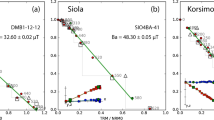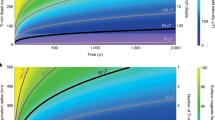Abstract
Techniques designed to obtain the intensity of the geomagnetic field by thermal demagnetization are subject to error due to differences between the ancient and laboratory cooling rate1–3 and alteration in the physical and chemical properties of the magnetic grains which can lead to a systematic overestimate of the field by as much as 50%. A new technique is proposed here which uses the change in moment with time at a fixed temperature in conjunction with the magnetization acquired on cooling to determine the ancient field and ancient cooling rate. This new technique also appears to be able to detect alteration with greater sensitivity.
This is a preview of subscription content, access via your institution
Access options
Subscribe to this journal
Receive 51 print issues and online access
$199.00 per year
only $3.90 per issue
Buy this article
- Purchase on Springer Link
- Instant access to full article PDF
Prices may be subject to local taxes which are calculated during checkout
Similar content being viewed by others
References
Walton, D. Nature 286, 245–247 (1980).
Fox, J. M. W. & Aitken, M. J. Nature 283, 462–463 (1980).
Dodson, M. H. & McLelland Brown, E. J. J. geophys. Res. 85, 2625 (1980).
Walton, D. Nature 277, 643–644 (1979).
Author information
Authors and Affiliations
Rights and permissions
About this article
Cite this article
Walton, D. Errors and resolution of thermal techniques for obtaining the geomagnetic intensity. Nature 295, 512–515 (1982). https://doi.org/10.1038/295512a0
Received:
Accepted:
Issue Date:
DOI: https://doi.org/10.1038/295512a0
This article is cited by
-
The secular variation of the geomagnetic field in Egypt in the last 5000 years
Pure and Applied Geophysics PAGEOPH (1987)
-
Re-evaluation of Greek archaeomagnitudes
Nature (1984)
Comments
By submitting a comment you agree to abide by our Terms and Community Guidelines. If you find something abusive or that does not comply with our terms or guidelines please flag it as inappropriate.



